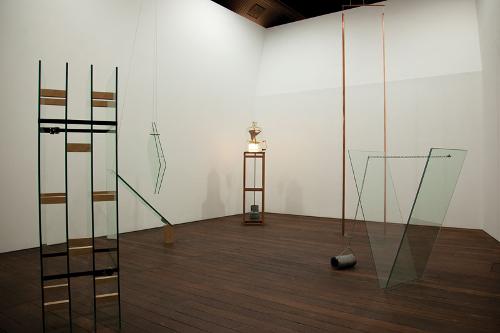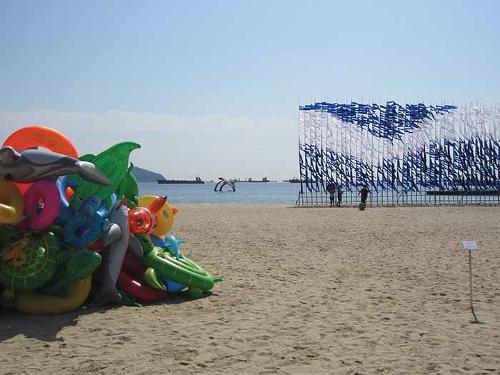.jpg)
The title Beyond Bravura elicits ideas of extreme brilliance, advanced technical capacity and exceptional quality. In Gallery One at JamFactory, the physicality of this phrase is understood in the context of contemporary ceramics, with a collection of pottery that has been carefully crafted by eminent artist Stephen Bowers. Many of the works exhibited were produced over the last four years, while some date back to the early 1990s when Bowers held the role of Head of Ceramic Workshop at the JamFactory. His affiliation with the renowned studio, gallery and shop is a long-standing one, from 2004–10 he was Managing Director. The exhibition's introductory phrase “JamFactory Icon” honours his contribution to the organisation.
The three-dimensionality of Bowers’ work is accentuated, with large vases placed on plinths, plates hung on temporary walling and mugs recessed into custom-built displays that allow his objects to be approached from all sides. Decorative elements such as native flora and perching cockatoos are replicated, larger than life, beside wall text that explains, in brief, many of the essential elements of his practice. Included is information about his designs, patterns, techniques and traditions, all of which create obvious access points for audiences to engage with Bowers’ process-driven craft.
Particular to this showcase of works is the range of themes and subjects that have proliferated throughout the artist’s oeuvre. In rather broad terms, these include “Growing up in Oz,” “Appropriating Ideas,” “Honouring Traditional Skills,” and the “Aussie Larrikin.” Discernible within representations of these themes are specific images, figures and influences that have proved central to Bowers’ creative journey. Some emerge from picture books and literature such as the characters brought to life in May Gibbs’ illustrations, found in Blue and White Staffordshire Mugs (c. 1992–94), or by Lewis Carroll, where in Antipodean Tea Party (2010) Alice and the Mad Hatter appear topsy-turvy around a platter. Others are generated from popular culture, for example head-turning sideshow clowns or the contemporarily designed cannot-live-without USB flash drive.
Considering art-historical perspectives, Bowers re-casts the quintessential antipodean imagery of Indigenous subjects and disproportionately rendered Australian fauna in works such as Fracture (2011) and Stubbs meets Spode (2011). These works remind us of the aesthetic debates about form and its embellishments expressed through an antipodean lens. They also draw engagement in subsequent socio-cultural discussions concerning history and the position of those nations peripherally placed in relation to nineteenth-century Europe. Both are intrinsically linked to the Enlightenment and highlight the problematic nature of imagery representative of Australia originating in this early era that was often produced by British artists.
Bowers utilises such tensions regarding Australian identity and heritage by juxtaposing them with his own personal experiences of “Oz” and depicts them together on the surfaces of an array of objects, both functional and ornamental. Visual resolution is achieved with a degree of irony, humour and playfulness that acknowledges the place and role of “icon” within the canon of Australiana.
Complementing distinct expressions of Australian imagery are the oriental-inspired designs found on dinnerware from the nineteenth-century, William Morris wallpapers and eighteenth century Kandahar textiles that Bowers appropriates into his own unique compositions. Prevalent also is the willow pattern, the typical blue and white designs synonymous with English dinner and serving ware, and export ware from China. Variations of this design feature in several works including Icarus in the Antipodes (2012) and Blue Chintz (undated).
A focal point of Bowers’ practice is his persistent tribute to painting within the ceramic tradition. The pair of vases William Morris Camouflage Vases (2012) exemplify his skill in design and application, where underglaze, on-glaze, enamel and gold lustre are exquisitely combined. Bowers’ capabilities are further evidenced via scale, where he paints in minute detail on regular sized teapots, mugs and large platters, as well as colossal sized drinking vessels such as the cup and saucer True Blue (2010), which measures 800 mm in diameter. Contrasting with the ceramic medium, his painting also extends to surfboards, where his repertoire of iconography is applied in synthetic polymer to wood and fibreglass, for example Antipodean Willow Surfboard (2012).












